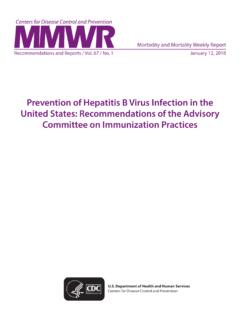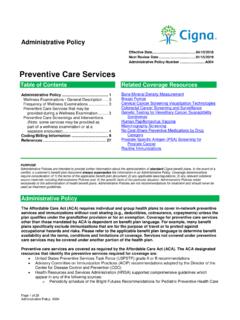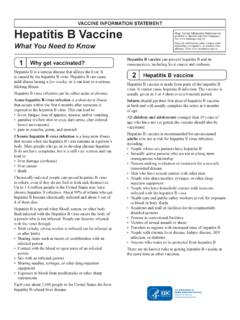Transcription of 2019 National YRBS Data Users Guide - Centers for Disease ...
1 Youth Risk Behavior Surveillance System (YRBSS) 2019 YRBS Data User s Guide August 2020 2 0 1 9 Y O UT H R I S K B E H A V I O R SU R V E Y 2019 YRBS Data User s Guide Table of Contents Introduction to the YRBSS .. 1 1 Uses of YRBSS 1 Components of the YRBSS .. 1 2 For More Information .. 2 Sample 3 School Level Selection .. 3 Class Level 3 Response Rates.
2 3 Data 4 4 Single Question 4 Height and Weight 4 Body Mass Index (BMI) 5 Biologically Implausible Value Edits .. 5 Logical Consistency 6 Edit 6 Subverting 10 Calculated Variables .. 11 11 11 Percentile, Overweight, and 12 Dichotomous 13 QN# Variables: .. 13 QNword Variables .. 13 Data Analysis 14 14 14 PSU .. 14 For More Information .. 14 Analysis Software Technical Notes .. 15 15 2 0 1 9 Y O UT H R I S K B E H A V I O R SU R V E Y Software 15 Sexual Minority Data Analysis 16 16 16 Codebook.
3 17 17 Data 17 Variable Name .. 17 Question Code and 17 Unweighted Frequency .. 17 Weighted Percentage .. 17 Appendix A: National High School YRBS Questions and Dichotomous 18 Appendix B: National YRBS Supplemental (QNword) 52 Appendix C: National High School YRBS Codebook .. 54 2 0 1 9 Y O UT H R I S K B E H A V I O R SU R V E Y Introduction to the YRBSS Introduction The YRBSS was developed in 1990 to monitor priority health risk behaviors that contribute markedly to the leading causes of death, disability, and social problems among youth and adults in the United States.
4 These behaviors, often established during childhood and early adolescence, include Behaviors that contribute to unintentional injuries and violence. Sexual behaviors that contribute to unintended pregnancy and sexually transmitted infections , including HIV infection. Alcohol and other drug use. Tobacco use. Unhealthy dietary behaviors. Inadequate physical activity. In addition, the YRBSS monitors the prevalence of obesity and asthma. From 1991 through 2019, the YRBSS has collected data from more than million high school students in more than 2,100 separate surveys.
5 Uses of YRBSS The YRBSS was designed to Results Determine the prevalence of health risk behaviors. Assess whether health risk behaviors increase, decrease, or stay the same over time. Examine the co-occurrence of health risk behaviors. Provide comparable National , state, territorial, tribal, and local data. Provide comparable data among subpopulations of youth. Monitor progress toward achieving the Healthy People objectives and other program indicators. Components of The YRBSS includes National , state, territorial, tribal government, and local the YRBSS school-based surveys of representative samples of 9th through 12th grade students.
6 These surveys are conducted every two years, usually during the spring semester. The National survey, conducted by CDC, provides data representative of 9th through 12th grade students in public and private schools in the United States. The state, territorial, tribal government, and local surveys, conducted by departments of health and education, provide data representative of mostly public high school students in each jurisdiction. The YRBSS also includes additional surveys conducted by CDC: August 2020 Page 1 2 0 1 9 Y O UT H R I S K B E H A V I O R SU R V E Y A middle school survey conducted by interested states, territories, tribal governments, and large urban school districts.
7 A 2010 study to measure physical activity and nutrition-related behaviors and determinants of these behaviors among a nationally representative sample of high school students. A series of methods studies conducted in 1992, 2000, 2002, 2004, and 2008 to improve the quality and interpretation of the YRBSS data. The National Alternative High School Youth Risk Behavior Survey conducted in 1998 among a representative sample of almost 9,000 students in alternative high schools. The National College Health Risk Behavior Survey conducted in 1995 among a representative sample of about 5,000 undergraduate students.
8 Methods The National Youth Risk Behavior Survey (YRBS) uses a three-stage cluster sample design to produce a representative sample of 9th through 12th grade students. The target population consisted of all public, Catholic, and other private school students in grades 9 through 12. A weighting factor was applied to each student record to adjust for nonresponse and the oversampling of black and Hispanic students in the sample. The final, overall weights were scaled so the weighted count of students was equal to the total sample size, and the weighted proportions of students in each grade matched population projections for each survey year.
9 Because of the complexity of the cluster sampling design used, a statistical software package that can calculate sampling variance appropriately must be used. This document provides the information needed to correctly use and analyze data from the 2019 National YRBS. For More Visit the YRBSS web site at for more information on the Information YRBSS, its methodology, data analysis, and answers to frequently asked questions. August 2020 Page 2 2 0 1 9 Y O UT H R I S K B E H A V I O R SU R V E Y Sample Description School Level All regular public, Catholic, and other private school students, in grades 9 Selection through 12, in the 50 States and the District of Columbia were included in the sampling frame for the 2019 National YRBS.
10 Puerto Rico, the trust territories, and the Virgin Islands were excluded from the frame. Schools were selected systematically with probability proportional to enrollment in grades 9 through 12 using a random start. One hundred and eighty-one schools were sampled. Class Level All classes in a required subject or all classes meeting during a particular Selection period of the day, depending on the school, were included in the sampling frame. Systematic equal probability sampling with a random start was used to select classes from each school that participated in the survey.












